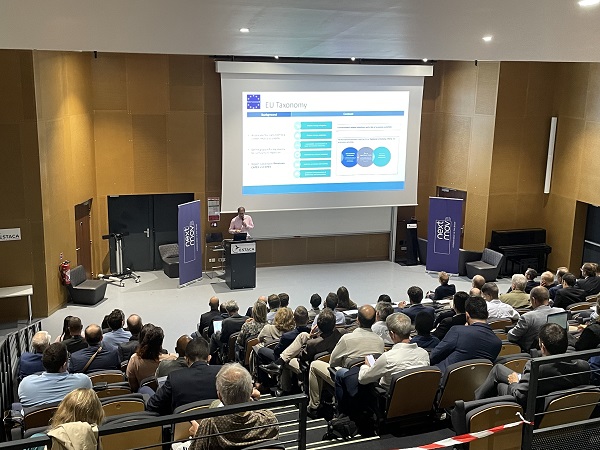[ad_1]
The NextMove competitiveness cluster co-organized a meeting on October 3 around a theme intrinsically linked to the electric vehicle sector: power electronics. The opportunity for us to return in more detail to the issues surrounding this vast subject with one of the representatives of this cluster with more than 600 members, and which thus claims the title of the largest French network of scientific and technology in the automotive and mobility sector.
Organized in the premises of the École supérieure des techniques aéronautiques et de construction automobile (ESTACA), on the Paris-Saclay Campus, this 3rd edition of the TechShow dedicated to power electronics attracted no less than 120 participants, who thus had the opportunity to discover the projects carried out on a European scale by five heads of sectors – Valeo, Vitesco, Renault, STMicroelectronics and Murata – supported by their numerous partners.
Mobility Director of NextMove, Geoffroy Martin gives us a quick overview of the event and goes into detail on the importance ofpower electronics for the electric vehicle sector. He also gives us his vision of the factors that could allow France to position itself as a European – or even global – leader on this subject.
Engineering Techniques: What is your role within NextMove? What do your missions consist of?

Geoffroy Martin : I have been working within the NextMove competitiveness cluster for a dozen years. My mission consists of leading committees of experts, with the aim of supporting innovation projects, projects initially focused on the subjects “ traction chain » and “energy management”, and now on the theme “materials, comfort and environment”.
Collectively, our role is to promote collaborative innovation, to work in a sector to prepare the mobility of tomorrow. We are, historically, very focused on the automobile, but we have gradually opened up to all other types of land mobility – public transport, soft mobility, etc. – but also to all the tools that can help move from one mobility to another, as well as all the means that make it possible to produce these mobility tools. This last part, focused on industrial performance, is not part of my scope of action; I remain focused on aspects related to innovation in mobility products and services.
On October 3, you co-organized the 3rd edition of the Power Electronics TechShow… What were the objectives of this day?
This is a theme that we are particularly looking to bring to life. This interest stems from a program launched in 2020 around this subject by the Automotive and Mobility Platform (PFA), which represents the sector.
We are currently experiencing a revolution in the field of power electronics, with the arrival of “large gap” materials which are gallium nitride (GaN) and silicon carbide (SiC). These materials have very specific physical properties, which make it possible to obtain very significant gains in efficiency, compactness and yield. They therefore make it possible to improve the performance of electricity conversion systems, while reducing their costs.
This 2023 edition was thus an opportunity for us to present major European projects initiated thanks to this PFA program, projects that we call IPCEIfor “important projects of common European interest”, in front of more than 120 participants gathered for the occasion.
These projects are really intended to lead to a phase of industrialization. We had the opportunity to discover the projects carried out by five heads of sectors: Valeo, Vitesco, Renault, STMicroelectronics and Murata. Each of these projects involves the establishment of collaborations and partnerships with other players, and thus involves a large part of the sector, at national and European level.
In addition to making these projects known as such, the objective of this day was also to encourage participants to submit their own projects. The financing offer at national and European level is indeed quite extensive today. Project leaders therefore have every interest in coming together to benefit from it. NextMove is also there to help them answer these calls and find the right partners.

Generally speaking, what are the functions, what are the components of electric vehicles that could benefit from progress in power electronics?
There are three main families of organs involved. The first concerns the on-board charger. This device forms the link between the home charging station and the battery, by converting the alternating current from the sector into the direct current necessary for recharging. However, any conversion involves losses, particularly through heating. These losses currently amount to around 10% or 20%, depending on the brands of onboard chargers, or even up to 30% for the oldest models… The whole challenge of power electronics consists of this to achieve this conversion with as little loss as possible.
This is valid for the second category of organs concerned by power electronics: the inverter. This device makes it possible to convert the direct current from the battery into alternating current, in order to send it to the engine. Each efficiency point gained on this inverter thus results either in a gain in autonomy, or in a reduction in the size of the batteries, and therefore ultimately in the purchase cost of the electric vehicle. This once again illustrates the interest in developing high-performance power electronics.
Finally, the last of these components is the “DC-DC” converter, which allows the 400 or 800 V of the battery to be lowered to the 12 V voltage which operates the entire on-board network: lights, car radio, etc.
The emergence of the “large gap” materials that I mentioned will therefore make it possible to improve the yields of all these organs, but also to increase their compactness and reduce their mass. These technologies remain relatively young, so their cost is generally a little higher than that of more conventional solutions. However, when considering the system as a whole, they are already proving advantageous thanks to the weight and volume they save. Ultimately, they should also save costs.
The electronics sector and the automotive sector have the objective of building a “French team” in power electronics… What are the origins of this ambition?
We started from a very simple observation: today, a large part of the semiconductor industry is represented by players based in Asia. However, we have real strengths to showcase, with high-performance academic research and well-positioned players such as ST or Exagan. Unfortunately, Asian competition has caused a lot of damage to the national electronics industry, so today we need to redevelop it from an industrial point of view. Covid has also revealed our dependence on this type of system. We therefore have every interest in giving ourselves the means to produce them in France in order to remedy this crisis, which persists. Added to this are very strong geopolitical tensions, particularly on the side of Taiwan, one of the major suppliers of these semiconductors with TSMC for example…
This objective also responds to real issues of sovereignty, competitiveness, and local employment. To give an order of magnitude, the three systems I mentioned – on-board charger, inverter and DC-DC – alone represent a share equivalent to that of a gasoline engine in the overall cost of an electric vehicle. We therefore have every interest in equipping ourselves with the tools necessary to produce these systems.
In your opinion, what conditions must be met to enable this ambition to become a reality?
The first of these concerns skills: we particularly need to have a large number of engineers. Then, we also need to be at the forefront of innovation. The NextMove competitiveness cluster has a big role to play in this regard, by bringing together players: manufacturers, equipment manufacturers, etc. but also start-ups, SMEs and research laboratories, such as the CEA-Letithe SATIE, VEDECOMl’IRT Saint Exupéry…
We are historically focused around the automotive sector, and less electronics. This is why we have joined forces with the Alliance of Components and Systems for the Electronic Industry (ACSIEL), so that we can combine our two ecosystems. We must ensure that all these skills speak to each other and can combine. This is also one of the objectives of an event such as the TechShow.
The ultimate key that will allow France to establish itself as a European – or even global – leader in power electronics is also the development of factories, across the entire value chain, from the foundries that will manufacture GaN and SiC wafers, to Electronic manufacturing services (EMS), responsible for installing components on electronic cards. This entire industrial sector remains to be mobilized.
The involvement of public authorities on this subject is not yet as strong as for the development of battery factories, for example. However, things still happen. STMicroelectronics and GlobalFoundries notably announced a huge factory project in Crolles, in Isère ; an investment of €7.5 billion, partly financed thanks to public support of €2.9 billion. We cannot therefore say that nothing is happening, even if progress remains to be made.
The subject of power electronics is undoubtedly a little less sexy than that of batteries, or hydrogen for example, it is nevertheless a central, strategic subject, which absolutely must be helped. Our Asian competitors are particularly aggressive, so we must be resourceful and competitive, in order to counter their low-cost offerings through innovation. We must do everything not to miss the boat!
[ad_2]
Source link